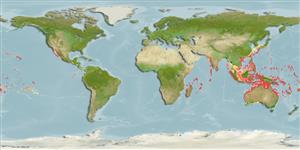Common names from other countries
>
Kurtiformes (Nurseryfishes, cardinalfishes.) >
Apogonidae (Cardinalfishes) > Apogoninae
Etymology: Apogon: Greek, a = without + Greek pogon = chin, beard (Ref. 45335).
More on author: Garman.
Environment: milieu / climate zone / depth range / distribution range
Ökologie
seewasser riff-verbunden; tiefenbereich 18 - 55 m (Ref. 37816). Tropical
Indo-Pacific. Replaced by Apogon coccineus from the Red Sea to Persian Gulf and by Apogon erythrinus in the Hawaiian Islands (Ref. 37816).
Size / Gewicht / Alter
Maturity: Lm ? range ? - ? cm
Max length : 5.0 cm TL Männchen/unbestimmt; (Ref. 90102); common length : 4.5 cm SL Männchen/unbestimmt; (Ref. 37816)
Rückenflossenstacheln (insgesamt) : 7; Rückenflossenweichstrahlen (insgesamt) : 9; Afterflossenstacheln: 2; Afterflossenweichstrahlen: 8. Distinguished by having the following characteristics: dorsal-fin rays VI-I, 9; anal-fin rays II,8; pectoral fin rays 13; pelvic fin rays I,5; pored lateral line scales 24; predorsal scales 5-6; large scale between first dorsal fin and lateral line 1; circumpeduncular scales 12; total gill rakers 15-16, developed gill rakers 8-9; full scale between first dorsal fin and lateral line 1, often with smaller second scale (Ref. 93839). Resembles A. unicolor but distinguished by fewer spines in the 1st dorsal fin (6 against 7), large scales, and fewer lateral line scales (23 against 25). Body color uniformly dark reddish, each scale mottled with brown. Attains 10 cm TL. Further characterized by having a semi-transparent red color, with a thin, dark red stripe on mid-lateral surface of the body (Ref. 93839) greatest depth of body 2.7-3.0 in SL (Ref. 90102).
Found on inshore reefs, lagoons, and seaward reefs (Ref. 37816). Nocturnal species (Ref. 7300). Feeds on small benthic crustaceans (Ref. 37816). Maximum depth reported taken from Ref. 57178.
Life cycle and mating behavior
Maturities | Fortpflanzung | Spawnings | Egg(s) | Fecundities | Larven
Mouthbrooders (Ref. 240). Distinct pairing during courtship and spawning (Ref. 205).
Paxton, J.R., D.F. Hoese, G.R. Allen and J.E. Hanley, 1989. Pisces. Petromyzontidae to Carangidae. Zoological Catalogue of Australia, Vol. 7. Australian Government Publishing Service, Canberra, 665 p. (Ref. 7300)
IUCN Rote Liste Status (Ref. 130435)
Warning: mysqli::__construct(): (HY000/1040): Too many connections in /var/www/html/includes/func_getlabel.php on line 46
Can't connect to MySQL database (fbapp). Errorcode: Too many connections
